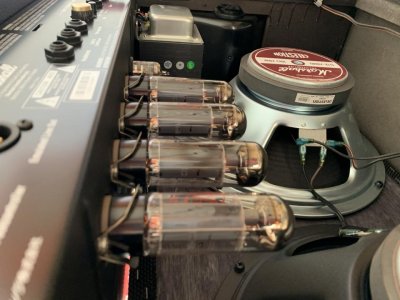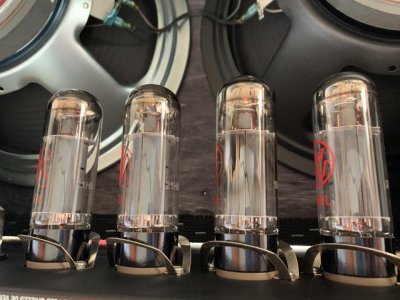You are using an out of date browser. It may not display this or other websites correctly.
You should upgrade or use an alternative browser.
You should upgrade or use an alternative browser.
Marshall JMD problem
- Thread starter arten
- Start date
Lake Placid Blues
New member
Re: Marshall JMD problem
Biasing the JMD is not too difficult. The bias ports are on the board. You will need to pull the chassis. Locate CON-6. There are 3 pins sticking up. The middle pin is the ground. The two outboard pins is where you measure millivolts with the meter. Next to CON6 are two mini pots that are used to adjust the bias for each pair of tubes. Adjust the associated pot until you get 76 per side with your meter set to mv DC.
Just follow the normal safety precautions of not touching anything in the amp with your bare hand, and use one hand at a time, and an insulated mini screw driver to adjust the pots...and so forth. Be careful that the probes of your meter do not touch the wrong pins. In the case of the JMD you do not want any static electricity jumping from you to the amp. Get rid of any static electrons first by zapping your self of any static electricity by touching anything to ground.
Biasing the JMD is not too difficult. The bias ports are on the board. You will need to pull the chassis. Locate CON-6. There are 3 pins sticking up. The middle pin is the ground. The two outboard pins is where you measure millivolts with the meter. Next to CON6 are two mini pots that are used to adjust the bias for each pair of tubes. Adjust the associated pot until you get 76 per side with your meter set to mv DC.
Just follow the normal safety precautions of not touching anything in the amp with your bare hand, and use one hand at a time, and an insulated mini screw driver to adjust the pots...and so forth. Be careful that the probes of your meter do not touch the wrong pins. In the case of the JMD you do not want any static electricity jumping from you to the amp. Get rid of any static electrons first by zapping your self of any static electricity by touching anything to ground.
Re: Marshall JMD problem
Thank you so much!
You were right, it's not too difficult though it was difficult to get it perfecly on 76 each but after a couple of tries i got it!
Biasing the JMD is not too difficult. The bias ports are on the board. You will need to pull the chassis. Locate CON-6. There are 3 pins sticking up. The middle pin is the ground. The two outboard pins is where you measure millivolts with the meter. Next to CON6 are two mini pots that are used to adjust the bias for each pair of tubes. Adjust the associated pot until you get 76 per side with your meter set to mv DC.
Just follow the normal safety precautions of not touching anything in the amp with your bare hand, and use one hand at a time, and an insulated mini screw driver to adjust the pots...and so forth. Be careful that the probes of your meter do not touch the wrong pins. In the case of the JMD you do not want any static electricity jumping from you to the amp. Get rid of any static electrons first by zapping your self of any static electricity by touching anything to ground.
Thank you so much!
You were right, it's not too difficult though it was difficult to get it perfecly on 76 each but after a couple of tries i got it!
Last edited:
Re: Marshall JMD problem
today I was playing my jmd through my hx fx in 4cm. From some patches I did get no sound but that seemed to be a helix problem. I downgraded the hx and turned the amp back on.
It made a louder and louder buzzing or humming sound, than a big POP and now it doesn't make a sound any more.
Any idea's what happened and where I should look?
today I was playing my jmd through my hx fx in 4cm. From some patches I did get no sound but that seemed to be a helix problem. I downgraded the hx and turned the amp back on.
It made a louder and louder buzzing or humming sound, than a big POP and now it doesn't make a sound any more.
Any idea's what happened and where I should look?
Re: Marshall JMD problem
I checked the fuse and it's intact.
I also noticed that one of the powervalves which I replaced two weeks ago seems "burned". It's the same valve that seemed damaged on the original ones.
I can turn the amp on and it starts humming a little, but switching it from standby to powered doesn't do anything.
I've added a picture of the tubes below. It's hard to take a good picture because of the reflection, but there seems like a burn stain on the glass and on the plate at the top of the valve


I checked the fuse and it's intact.
I also noticed that one of the powervalves which I replaced two weeks ago seems "burned". It's the same valve that seemed damaged on the original ones.
I can turn the amp on and it starts humming a little, but switching it from standby to powered doesn't do anything.
I've added a picture of the tubes below. It's hard to take a good picture because of the reflection, but there seems like a burn stain on the glass and on the plate at the top of the valve


Last edited:
Lake Placid Blues
New member
Re: Marshall JMD problem
The fuse can look good but still be bad. Check it with a meter.
You can check voltages at the tube socket without tubes installed and the amp off standby. Do this and see if there is anything anomalous with any the pin sockets at any of the sockets.
The slight hum when you first switch on the mains is normal.
The fuse can look good but still be bad. Check it with a meter.
You can check voltages at the tube socket without tubes installed and the amp off standby. Do this and see if there is anything anomalous with any the pin sockets at any of the sockets.
The slight hum when you first switch on the mains is normal.
Re: Marshall JMD problem
I just tried the amp with the headphone and direct out and that works as it should, so the problem is definitely with the power amp section, so I think I can rule out the fuse no? without the fuse the amp wouldn't do anything correct?
To check the voltages:
- what do you mean with 'the amp off standy"?
- what should the normal read out be for every pin
I just tried the amp with the headphone and direct out and that works as it should, so the problem is definitely with the power amp section, so I think I can rule out the fuse no? without the fuse the amp wouldn't do anything correct?
To check the voltages:
- what do you mean with 'the amp off standy"?
- what should the normal read out be for every pin
Lake Placid Blues
New member
Re: Marshall JMD problem
It appears that the tube in the same socket as before may have red plated causing the fuse to blow. It could be coincidence or it could be an ongoing problem. Check the voltage at pin 5 in that socket vs the others. You will need to replace the fuse first. Also make sure you are using slow blow fuses. If it is a fast blow fuse you will keep blowing fuses for no other reason. Pin 5 should be about negative 50 volts. Pin 3 is the plate voltage which will probably be in the high 400s. Pin 4 is the screen grid and should be about the same as the plates. These are DC so set your meter appropriately.
There are the mains fuse and the HT fuse. The HT fuse blows if there is a tube problem, leaving the digital preamp working but killing the tube power amp.
It appears that the tube in the same socket as before may have red plated causing the fuse to blow. It could be coincidence or it could be an ongoing problem. Check the voltage at pin 5 in that socket vs the others. You will need to replace the fuse first. Also make sure you are using slow blow fuses. If it is a fast blow fuse you will keep blowing fuses for no other reason. Pin 5 should be about negative 50 volts. Pin 3 is the plate voltage which will probably be in the high 400s. Pin 4 is the screen grid and should be about the same as the plates. These are DC so set your meter appropriately.
There are the mains fuse and the HT fuse. The HT fuse blows if there is a tube problem, leaving the digital preamp working but killing the tube power amp.
